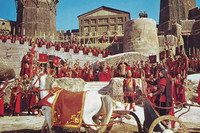Login form
Roman Empire
 What was the biggest, richest, and most powerful nation of ancient times? The mighty Roman Empire! Based in the city of Rome, it stretched across three continents and included millions of people. The Roman Empire lasted for 500 years.
What was the biggest, richest, and most powerful nation of ancient times? The mighty Roman Empire! Based in the city of Rome, it stretched across three continents and included millions of people. The Roman Empire lasted for 500 years.
ROME’S RISE TO POWER
According to legend, the city of Rome was founded in central Italy in 753 bc. As Rome grew richer and stronger, its soldiers took over nearby land. Rome’s well-trained, disciplined army was a fearsome fighting machine.
By 30 bc, Rome controlled most of Europe, North Africa, and the Middle East. To guard these conquests, the Romans built walls and military forts. They also built excellent roads so that soldiers could march quickly to trouble spots.
THE EMPIRE BEGINS
The Roman Empire began in 27 bc. That year, a tough, clever army commander won control of Rome after a long civil war. His name was Octavian, but the Romans called him Augustus. The title Augustus meant “honored or holy leader.” Augustus became the first Roman emperor. The month of August is named after him.
Augustus saw that Rome needed new government. He appointed professionals to manage the government’s money and make sure that enough food and fresh water reached the city of Rome. He reorganized the army and set up new police and firefighting teams. He encouraged family life by paying parents to have more children. He brought back old ceremonies to honor the gods who were said to guide and guard Rome.
By the time Augustus died in ad 14, he had linked Roman lands into a single awesome organization. This was the Roman Empire.
GOVERNMENT
Emperors remained in charge of the Roman Empire for almost 500 years. Some, like Nero, were tyrants. Some, like Commodus, were stupid and cruel. But most ruled well, and a few, like Trajan, were outstanding. When Roman emperors died, they were worshiped as gods.
Each province (region) of the empire was ruled by a governor. The governor was helped by trained officials and sometimes by local kings and chiefs. Everyone in the empire had to pay Roman taxes and obey Roman laws. They had to use Roman money, as well. Roman coins showed the emperor’s portrait. That way, everyone knew who was in charge!
WHO LIVED IN THE ROMAN EMPIRE?
Rome ruled over almost 50 million people in 27 bc. They included Greeks, Egyptians, Celts, Africans, Arabs, and Jews. Traditionally, Roman society was divided into two upper classes and two lower classes. Senators belonged to the highest class, and slaves to the lowest class. Over time, class became less important than wealth. After ad 212, each free person in the empire was treated equally, as a Roman citizen.
Everywhere they ruled, the Romans introduced their own language, Latin. They also brought their technology, art, entertainment, and building styles. Many Roman temples, theaters, roads, and aqueducts (bridges that carried water) still survive in many parts of Europe, North Africa, and the Middle East.
CAPITAL OF THE EMPIRE
The city of Rome was the center of the empire. It had temples for worship, law courts, houses and apartment buildings, sports arenas, and shops. It also had crowded streets, smells, dirt, and noise. About 1 million people lived in Rome in 27 bc, making it the largest city in the world.
People moved all the time from the countryside to Rome, but many could not find work. Emperors provided food and spectacles like gladiator shows to keep them content and stop them from rioting. One Roman writer said that emperors ruled by “bread and circuses.”
CONQUEST, THEN COLLAPSE
In the early years, the Roman Empire kept on growing. But later Roman emperors found the lands of the empire too vast and too varied to control. In ad 284, the Roman Empire was divided among four rulers. Emperor Constantine united it again in ad 324. Constantine became a Christian, and gave Christianity a favored position in the empire.
Soon after Constantine’s rule, the empire was attacked by fierce tribes from the north and east. Their raids caused terror and food shortages. In ad 395, the empire split into an Eastern Empire and a Western Empire. The wealthy Eastern Empire was ruled from Constantinople (now Istanbul). It remained strong. But poor and weak Western emperors could not defend their land. The last Western emperor was forced out of Rome by invaders in ad 476. The Eastern Empire survived as the Byzantine Empire.
The fall of the Roman Empire in 476 did not mean the end of Roman civilization. The Latin language lived on, and it developed into modern European languages such as French, Spanish, and Italian. Roman art, buildings, and writings influenced later cultures.
Source: Microsoft ® Encarta

